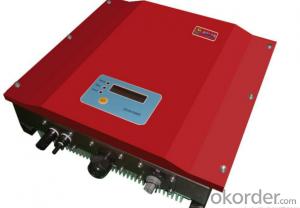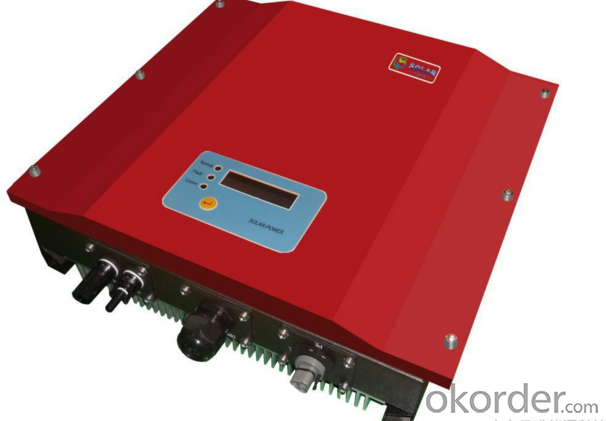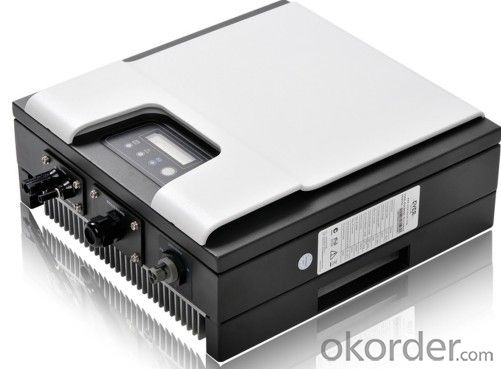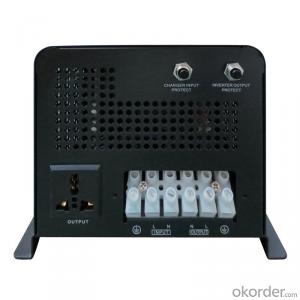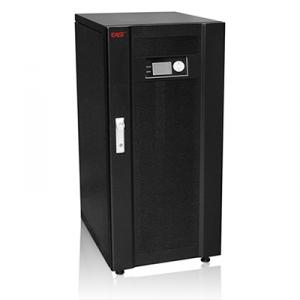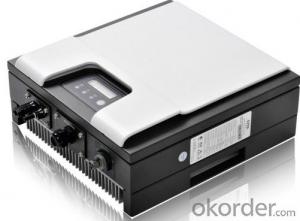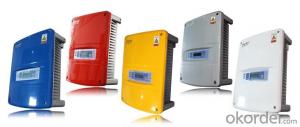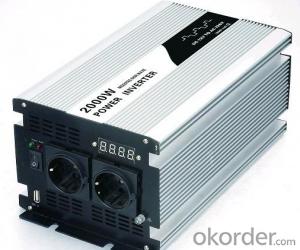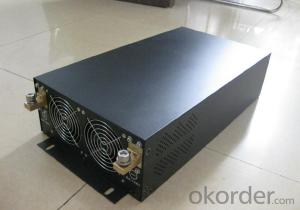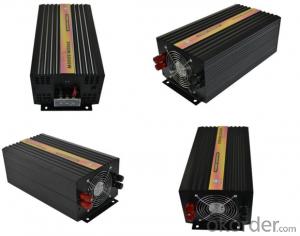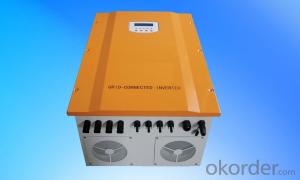Solar Inverter 500w - Three Phase 20k Solar Inverter Made in China
- Loading Port:
- Shanghai
- Payment Terms:
- TT OR LC
- Min Order Qty:
- 0 watt
- Supply Capability:
- 10000 watt/month
OKorder Service Pledge
OKorder Financial Service
You Might Also Like
Description of Three Phase 20k Solar Inverter
Solar ac power system consists of solar panels, charge controllers, inverter and battery; Solar energy does not include inverter dc power system. Inverter is a kind of power conversion device, inverter by incentives can be divided into self-excited oscillation inverter and separately excited oscillation inverter.
Features of Three Phase 20k Solar Inverter
Including three series,7 models
Both economical and high effciency
Smaller and lighter, 20Kw-TL weighs only 45kg
External Inductor
LCD screen with four buttons
Ethernet wifi or GPRS cascade data communication technology
User, installer, distrbutor, Omnik headquarter all-round remote control
Meets VDE-AR-N4105,BDEW approval
Built-in lightning protection module as an option
Advantages of Three Phase 20k Solar Inverter
Meets all the needs of medium power three phase inverter
Economy, high reliability and long life circle
Convenient to transport and install
Reducing machine temperature, extends device lifetime
Easy to operate, user friendly
One power station needs only one monitoring equipment
Real-time operation condition accessible, fast fault responding speed
Adjustable active and reactive power
Built-in lighting protection module
Technical Data of Three Phase 20k Solar Inverter
| Type | Omniksol-20k-TL |
| Input(DC) | |
| Max.PV Power | 21200W |
| Max,DC Voltage | 1000V |
| Nominal DC Voltage | 640V |
| Operating MPPT Voltage Range | 250-850V |
| MPPT Voltage Range at Nominal Power | 480-850V |
| Start up DC Voltage | 300V |
| Turn off DC Voltage | 250V |
| Max, DC Current(A/B) | 22A/22A |
| Max, Short Cicuit Current for each MPPT | 25A/25A |
| Number of MPP trackers | 2 |
| Max, Input Power for each MPPT* | 5000W |
| Number of DC Connection | A:3/B:3 |
| DC Connection Type | MC4 connector |
| Output(AC) | |
| Max,AC Apparent Power | 19200VA |
| Nominal AC Power (cos phi = 1) | 19200W |
| Nominal AC Voltage | 3/N/PE;220/380V |
| 3/N/PE;230/400V | |
| 3/N/PE;240/415V | |
| Nominal Grid Frequency | 50Hz/60Hz |
| Max, AC Current | 29.0A |
| Grid Voltage Range** | 185-276V |
| Grid Frequency Range** | 45-55Hz/55-65Hz |
| Power Factor | 0.9 capacitive... 0.9 inductive |
| Total Harmonic Distortion(THD) | <2% |
| Feed in Starting Power | 60W |
| Night time Power Consumption | <1W |
| Standby Consumption | <12W |
| AC Connection Type | Plug-in connertor |
| Efficiency | |
| Max,Efficiency | 98.2% |
| Euro Efficiency | 97.8% |
| MPPT Efficiency | 99.9% |
| Safety and Protection | |
| DC Insulation Monitoring | Yes |
| DC Switch | Optional |
| Residual Current Monitoring Unit (RCMU) | Integrated |
| Grid Monitoring with Anti-islanding | Yes |
| Electricity Fuse Protection | Yes |
| Protection Class | Ⅰ(According to IEC 62103) |
| Overvoltage Category | PV Ⅱ/ Mains Ⅲ(According to IEC 62109-1) |
| Reference Standard | |
| Safety Standard | EN 62109, AS/NZS 3100 |
| EMC Standard | EN 6100-6-1, EN 6100-6-2, EN 6100-6-3 EN 6100-6-4, EN 6100-3-2, EN 6100-3-3 |
| Grid Standard | VDE-AR-N4105. VDE-0126-1-1,G83/1,EN 50438,RD1699,CEI 0-21, AS4777,C10/C11 |
| Physical Structure | |
| Dimensions | 575x650x248mm |
| Weight | 45kg |
| Environmental Protection Rating | IP 65 (According to IEC 60529) |
| Cooling Concept | Natural convection |
| Mounting Information | Wall bracket |
| General Data | |
| Operating Temperature Range | -25℃ to +60℃(derating above 45℃) |
| Relative Humidity | 0% to 98%, no condensation |
| Max. Altitude (above sea level) | 2000m |
| Noise Type | <45dB |
| Isolation Type | Transformerless |
| Display | TFT Graphic Display |
| Data Communication | RS485(WiFi, GRPS optional) |
| Computer Communication | RS485(USB) |
| Standard Warranty | 10 Years (5-15 years optional) |
IMages of Three Phase 20k Solar Inverter
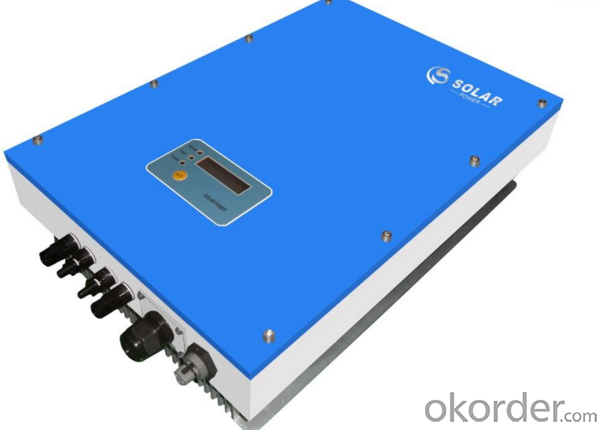
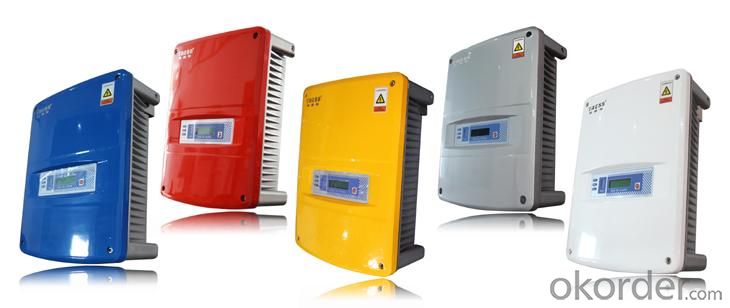
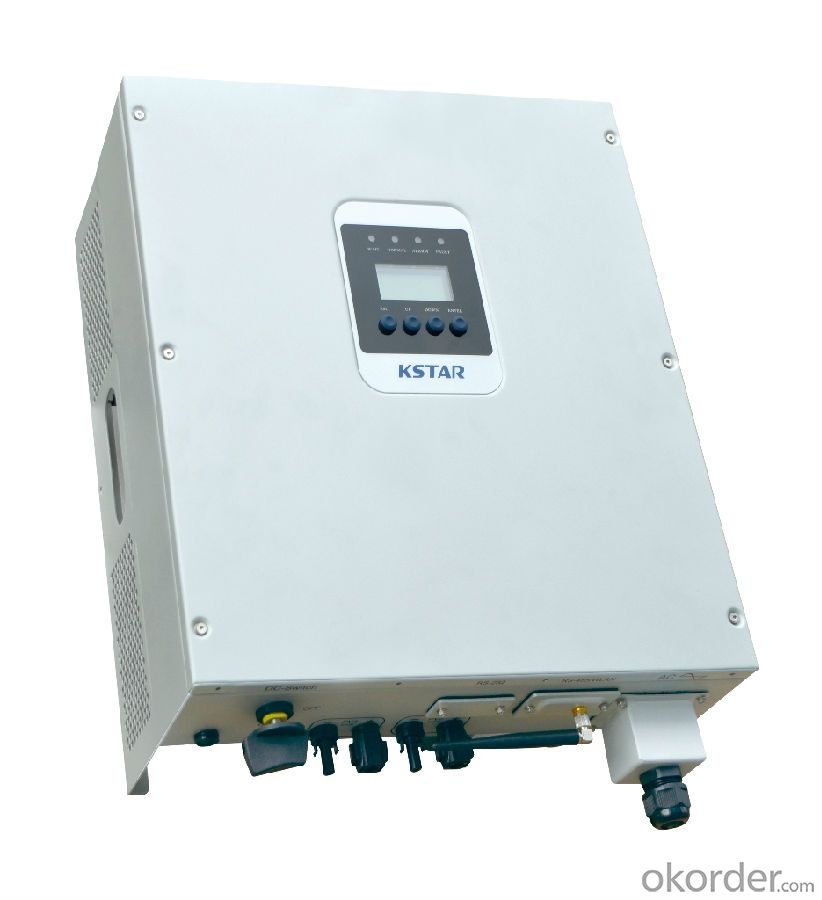
FAQ
Q: Do you have the CE, TUV, UL Certification?
A: We’ve already passed all the tests, and any certificate is available.
Q: Have you ever sold your products to companies in my country?
A: Of course, we have customers in all general PV markets, but I think we should expand our market share along with the market growth.
Q: When did your company set up? You are a new company, how can I believe your quality?
A: We entered into Solar PV industry in 2005, now we have several plants in manufacturing of a-Si and c-Si panels, and our capacity is 220MW per year. Till now we have already passed all the tests by authorized laboratories, e.g. TUV, CE, UL.
Q: Can you help us install the module if we cooperate with you?
A: We haven’t entered into installation sector, but we have the plan in near future.
Q: How do you pack your products?
A: We have rich experience on how to pack the panels to make sure the safety on shipment when it arrives at the destination.
Q: Can you do OEM for us?
A: Yes, we can.
Q: Can we visit your factory?
A: Surely, I will arrange the trip basing on your business schedule.
- Q: Photovoltaic grid-connected inverter without DC emc how will happen
- When solar or other light illuminates the PN junction of the semiconductor, a voltage (called a photogenerated voltage) occurs on both sides of the PN junction. This phenomenon is the famous photovoltaic effect.
- Q: Can a solar inverter be used in commercial or industrial applications?
- Yes, a solar inverter can be used in commercial or industrial applications. In fact, solar inverters are commonly used in these settings to convert the direct current (DC) generated by solar panels into alternating current (AC) that can be used to power various electrical devices and equipment in commercial and industrial buildings.
- Q: Can a solar inverter be used with different tracking algorithms?
- Yes, a solar inverter can be used with different tracking algorithms. Solar inverters are designed to convert the direct current (DC) power generated by solar panels into alternating current (AC) power suitable for use in homes and businesses. The tracking algorithm is responsible for optimizing the solar panel's output by adjusting the angle and orientation of the panels to maximize sunlight exposure. Different tracking algorithms can be utilized depending on factors such as location, weather conditions, and system requirements. Solar inverters are typically equipped with the capability to support various tracking algorithms, allowing for flexibility and customization to meet specific needs.
- Q: How does a solar inverter handle voltage unbalance in the grid?
- A solar inverter handles voltage unbalance in the grid by employing its control algorithms to monitor and regulate the output voltage. When the solar inverter detects an unbalanced grid voltage, it adjusts the output voltage accordingly to maintain a balanced supply. This is typically achieved by injecting reactive power or adjusting the phase angle of the output voltage to synchronize it with the grid. By actively managing voltage unbalance, a solar inverter ensures stable and reliable power conversion in the presence of grid voltage fluctuations.
- Q: Can a solar inverter be used without solar panels?
- No, a solar inverter cannot be used without solar panels. Solar panels are the primary source of energy for a solar inverter, which converts the direct current (DC) generated by the panels into alternating current (AC) that can be used to power electrical devices. Without solar panels, there is no source of renewable energy for the inverter to convert, rendering it useless.
- Q: What is the maximum AC voltage that a solar inverter can provide?
- The maximum AC voltage that a solar inverter can provide depends on the specifications of the specific inverter model. However, for most common residential and commercial solar inverters, the maximum AC voltage typically ranges between 208 and 240 volts.
- Q: What is the maximum efficiency at partial load for a solar inverter?
- The maximum efficiency at partial load for a solar inverter refers to the highest level of efficiency that can be achieved when the inverter is operating at less than its full capacity. This efficiency is typically lower than the maximum efficiency at full load, as the inverter may not be able to convert the same amount of energy with the same level of efficiency when it is not running at its maximum capacity.
- Q: How does a solar inverter handle electromagnetic interference (EMI)?
- A solar inverter typically handles electromagnetic interference (EMI) by incorporating various measures and technologies to minimize its impact. This includes using shielding materials and techniques to prevent EMI from affecting the internal electronics of the inverter. Additionally, filters and surge suppressors are employed to reduce EMI generated by the inverter from interfering with other electronic devices. Overall, the solar inverter aims to mitigate EMI issues to ensure optimal performance and minimize disruptions.
- Q: Is the PV inverter a current source or a voltage source?
- According to the waveform modulation method can be divided into square wave inverter, stepped wave inverter, sine wave inverter and modular three-phase inverter.
- Q: What is the role of galvanic isolation in a solar inverter?
- The role of galvanic isolation in a solar inverter is to provide electrical safety by separating the input and output circuits, preventing any direct electrical connection between them. This isolation helps protect the solar panels, the inverter, and the connected grid from potential electrical faults, such as ground faults or voltage surges. It also reduces the risk of electric shock and improves the overall performance and reliability of the solar inverter system.
Send your message to us
Solar Inverter 500w - Three Phase 20k Solar Inverter Made in China
- Loading Port:
- Shanghai
- Payment Terms:
- TT OR LC
- Min Order Qty:
- 0 watt
- Supply Capability:
- 10000 watt/month
OKorder Service Pledge
OKorder Financial Service
Similar products
Hot products
Hot Searches
Related keywords
